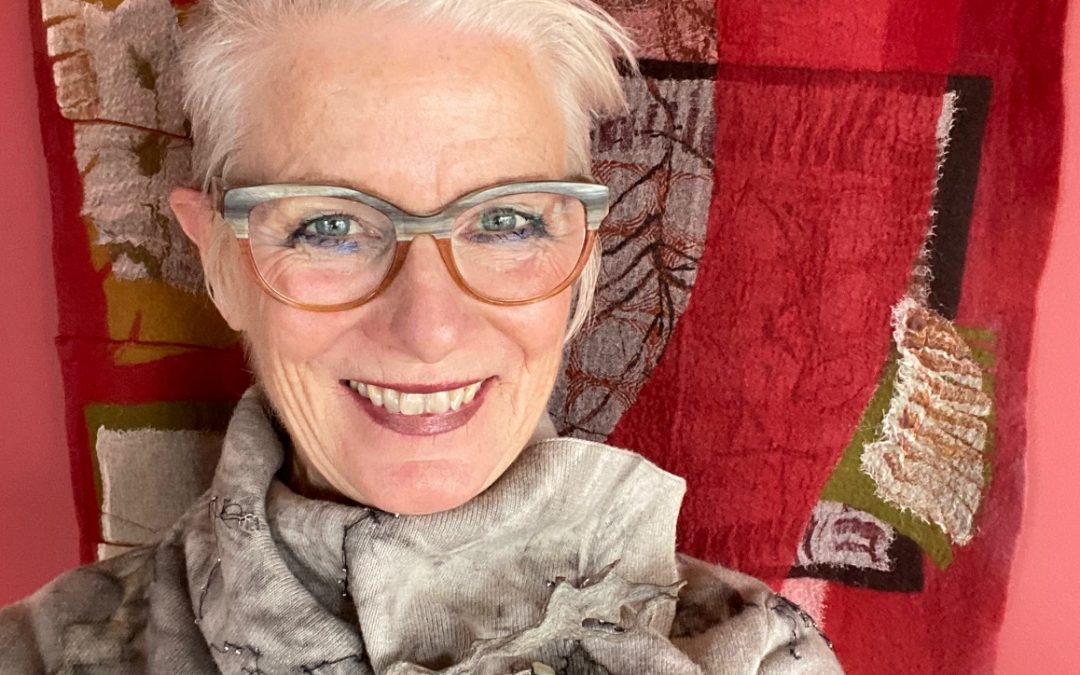A few minutes with Mary-Ellen…
Please tell us a little about yourself, your processes and practice…
Mary-Ellen is Geelong born, but has lived in Breamlea, Victoria for over 40 years. She is surrounded by protected wetlands, primary sand dunes and walks the long ocean beach daily. The changing colours of the wetlands and sea, the birdlife, and the crashing sound of the waves are the backdrop to her environs. These broad, open horizons of sea, sky, wetlands, are a constant inspiration – and a bountiful source of natural materials. Mary-Ellen is constantly collecting, admiring the natural treasure trove during her beach walks and bush camping expeditions. She loves to play with textile collages and assemblages, incorporating many elements of imperfect leaves, bark, sea glass, together with repurposed clothing from opp shops. Combining whimsy with a touch of humour, Mary-Ellen often celebrates the ‘found’ materials by retaining hints of the former purpose of the garment or found object.
Please tell us a little about your works, how they evolve, what inspires you, etc
If its natural materials I’ve spied, it is usually the subtle colours and patterns, the imperfections of the leaf, seashell, weathered wood, dried botanical specimens that grab my eye. With fabrics I’m always drawn to old silks, linens, natural fibres that I can repurpose by incorporating them into a 2 or 3-D assemblage. I simply play with these elements in front of me until they they ‘sing’. I am also keen of making assemblages that can be worn, whether is a ‘scarf-cape’, or a brooch or pendant. Flotsam from a beach walk may become a fun piece of ‘joollery’. Who needs diamonds anyway? I am always trying to redirect found objects away from landfill!
Can you please share with us what sort of studio or workspace you currently create in?
When I’m home, (which at present is about nine months of the year), I work in a small north facing room that has a large glazed section looking directly down and through my garden, from a height, onto the wetlands with the Thompson Creek meandering through. The tall eucalypts in the garden are a favourite ‘gym’ playground for the very colourful rosellas and parrots that I have named the Kamikaze Kids as they speedily swoop in, land on swaying branches, and then feed on the virgillias. They are hilarious and quite a distraction! The room is not large, so I’m constantly moving ‘boxes’ containing my various projects to make space for whatever project is underway. The rest of the year I’m usually ‘on the road’ in a campervan, so space is again limited.
During my road trips I set up materials, glues, projects on a folding table in under the awning, and often have to ‘anchor’ everything down against the elements at my chosen bush or beach camping location.
What are some of the processes and techniques you use?
I love to gather totally unrelated media (elements) together to create something that is quirky and fun; a bit of nonsense; or perhaps a work that causes the viewer to ponder the importance of caring for our environment. I’ve dabbled in eco-dyeing, mono prints, watercolour painting, hand and machine stitching, and will use all manner of materials be it recycled paper or plastics; twigs and leaves; silk men’s ties or scarves; scraps of fabric; old jewellery. I combine these elements with glue or stitches, often distressing the fabrics by burning them, or stretching and distorting them by fraying, or combining them within an old picture frame. One piece I particularly love is an abstract landscape made from a worn out kimono silk blouse I had, combined with stitches onto dressmakers’ tissue paper pattern and presented in an upcycled picture frame. This work really celebrates the changing autumnal colours of the succulents in the wetlands that are on my doorstep.
Please tell us what or who inspires and drives your creative practice.
Oh, there are so many sources of inspiration – anything that has been created from ‘repurposed’ materials always catches my eye! There are so many wonderful artists such as Rosalie Gascoigne, Lorraine Connelley-Northey, Jo Delafons and Shelley Rhodes whose work I absolutely love. I’m inspired by artists such as these women, who see the beauty in otherwise ‘trashed’ materials and they transform them into works of art that probe into conservation of the environment, and spark a conversation or contemplation of what we are doing (or not doing) to treasure our natural and delicate environs.
Is there a special piece of advice which you cherish, work by and would like to share?
To surround yourself with people who naturally have a ‘positive’ outlook is important to me – life’s too short to waste time with folk who give off a negative vibe. Music is vital – it can change your mood for the better and I love to sing and dance out loud (like no one’s watching!). It was Cicero who wisely recommended (and I’m paraphrasing a little here) that if you have access to a garden, a library, a bush or beach walk then you have everything you need.
